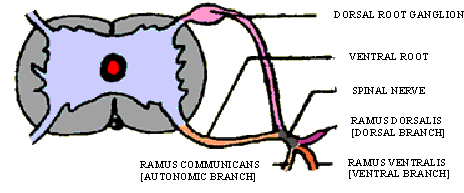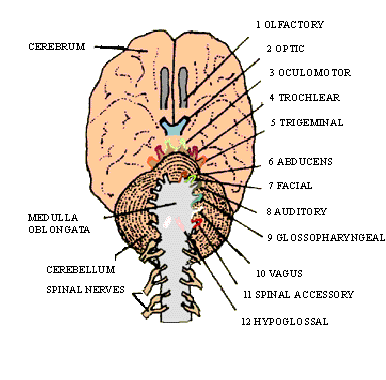|
PinkMonkey Online Study Guide-Biology
(ii) Spinal nerves : There are 8 cervical, 12
thoracic, 5 lumbar, 5 sacral and 1 coccygeal pairs of spinal nerves (31
pairs in all), which leave the spinal cord between adjacent vertebrae.
Each spinal nerve is formed by the joining of two roots, a dorsal root
(somatic and visceral sensory) and a ventral root (somatic and visceral
motor), to form a mixed nerve (Figure 23.6).

Click here for enlargement
Figure 23.6 Formation of spinal
nerve and its divisions
The nerve soon splits into three branches, each containing
some sensory and some motor fibers. Ramus dorsalis serves the skin and
muscles of the back, another innervates skin and muscles of the front
of the body, and the third serves internal organs (autonomic branch).
The cervical spinal nerves innervate diaphragm, skin and muscles of the
neck and arms, the thoracic to skin, muscles of thorax, the lumbar nerves
innerrate to skin and muscles of thigh, hip and lower leg, while the sacral
and coccygeal nerves innervate skin and muscles of leg, foot, genitalia
and abdomen. After many spinal nerves emerge from the cord, they branch
extensively to form networks of nerves called a plexus. Four of
such plexuses are formed (i.e. cervical plexus in the neck region, brachial
plexus in thorax, lumbar plexus in the abdomen and sacral plexus in the
lumbo-sacral region).

Figure 23.5 Cranial nerves (Underside of brain and part
of spinal cord)
[next page]
|
Table of Contents
23.0 Introduction
23.1 Central nervous system
23.2 The automatic nervous system
23.3 Receptors and effects
23.4 Reflex action - mechanism of nervous action
Chapter 24
|